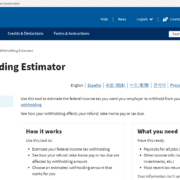Understanding The Basics of The Low-Income Housing Tax Credit Program
First launched by Washington lawmakers under the Tax Reform Act of 1986 and made permanent legislation in 1993, the low-income housing tax credit (LIHTC) was developed specifically to increase the number affordable rental homes here in the United States. The lack of affordable and available housing for extremely low-income (ELI) renter households continues to plague the U.S. A 2016 Affordable Housing Gap Analysis report revealed a severe shortage of accessible rental units to support our country’s 10.4 million ELI households. Leveraging the LIHTC incentive program can help investors and developers lower tax obligations and meet the needs of qualifying ELI households.
LIHTC Basics: What You Need to Know
Like most federally funded tax programs, the low-income housing tax credit is often both misunderstood and underutilized. Knowing some of the basic requirements and potential benefits of this lucrative government incentive can help optimize ROI when participating in the program.
As the most significant source of new, and most importantly, affordable, housing in the U.S., the LIHTC delivers a wide range of benefits to both investors and the surrounding community. As a dollar-for-dollar tax credit, the LIHTC incentive helps lower development debt, minimize the tax burden of owners, and increase the final profit margins of the investment. Additionally, participating in LIHTC development creates job and stimulates the regional economy, promoting further growth and opportunity to locals.
Leveraging the Benefits of the Low-Income Housing Tax Credit: What You Need to Know
Under the current regulations, the LIHTC program does not offer investors housing subsidies. Instead, this dollar-for-dollar tax incentive provides an indirect federal subsidy that can be used to fund both the construction and rehabilitation of cost-conscious rental properties. Qualifying developers are eligible to receive federal income tax credits over a 10-year period as long as they uphold two essential requirements:
- Acquire, rehab, or newly construct rental housing specifically for households that qualify as low income
- Operate the investment project under outlined low-income housing tax credit guidelines over a designated compliance duration
Additionally, the calculation of total eligible tax credits varies based on several key indicators, such as developer investment, percentage of created low-income units, project type, and whether the project is being financed by tax-exempt, private activity bonds.
The LIHTC Utilizes an Indirect Federal Subsidy
As part of the indirect subsidy process, developers sell the use of these credits to investors looking to reduce their overall federal tax burden. Soliciting investor support (also known as capital contribution), can help developers minimize the need for other outside financing, instantly lowering the builder’s total debt/service expenses. By decreasing the debt/service costs, the new development can more readily procure below-market rental revenue.
Qualifying for the LIHTC Benefit: Contact us Today for More Information
The LIHTC benefit covers a wide range of rental property types, including single-family dwellings, apartment buildings, townhouses, and duplexes. To qualify for the benefit, developers or owners must agree to meet the requirements of an income test for tenants to ensure landlords and owners remain compliant with the program. For more information on the benefits of the LIHTC program, contact Leone, McDonnell & Roberts today.








